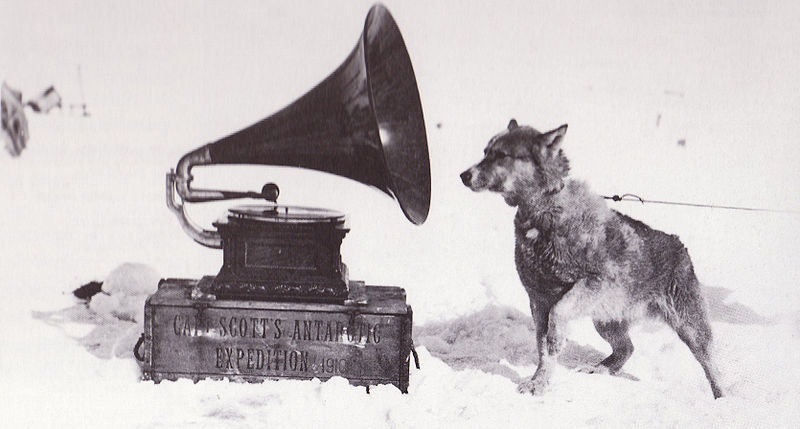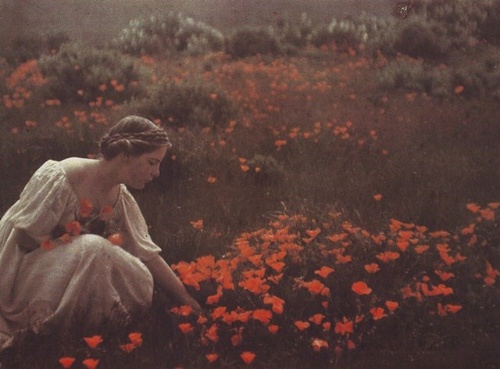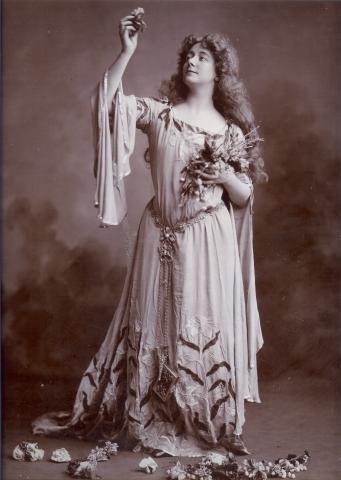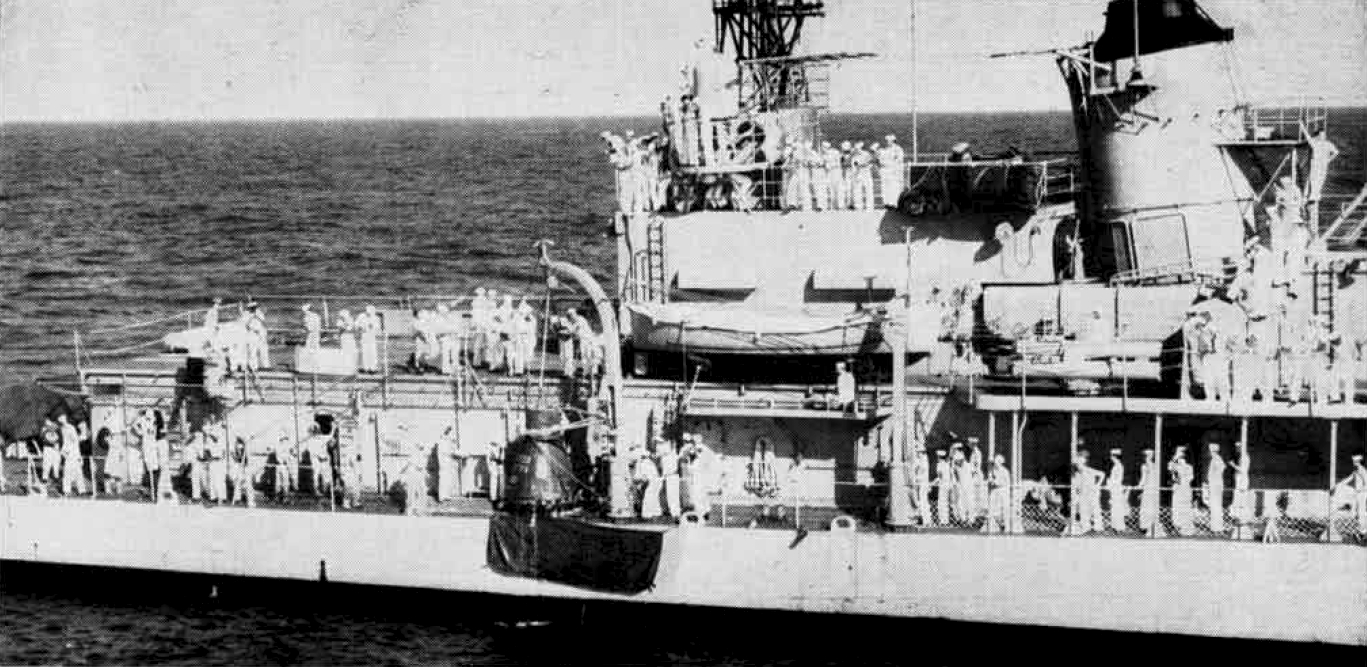Today’s Favorite Photograph is one of the great social commentary juxtaposition photographs of all time, Dorothea Lange’s, “There’s no way like the American way, 1937.” It shows African American men and women in Louisville, Kentucky, lining up to seek food and clothing from a relief station, in front of a billboard proclaiming, “World’s Highest Standard of Living.” This was taken during the Great Ohio River Flood of 1937. It is iconic and arguably Lange’s greatest image. It is a documentary of both its own time and all time. And it reminds us of the need for empathy and human kindness – a fundameental lesson that many have forgotten.
Category Archives: History of Photography
Favorite Photograph 2016 #6, Herbert Ponting “Sled dog listening to gramophone, c1910”

Figure 1 – Herbert Ponting’s “Sled dog listening to gramophone, 1910.” From the Wikicommons and in the public domain in the United States because of its age.
I am fascinated by the documentary photographs taken by Herbert Ponting and Frank Hurley of the British Antarctic expeditions of over a century ago. So, this morning I found myself revisiting all of these old friends and searching out which image was my favorite among the great Antarctic vistas. But in the end, I came back to the photograph by Ponting of Figure 1. This shows one of the led dogs on the ill-fated Scott Antarctic Expedition intrigued by the “human magic” of the grammophone.
This image is pointed for several reasons. It documents technology with other technologies. The fact is that in those days of the early twentieth century it was the dogs not the technology that resulted in success or failure. It was the profound and saprophytic relationship that had intertwined man and dog since prehistoric times. Ponting’s photograph is transitional between two centuries, between the Victorian and the Edwardian ages. And what this photograph ultimately says is that in that hostile and tenuous environment, where life and death hang in the balance and where the melodic voice of civilization is barely audible, it is the old alliance between man and canine that ultimately counts.
“He had been suddenly jerked from the heart of civilization and flung into the heart of things primordial.”
― Jack London, The Call of the Wild, 1903.
Favorite Photographs 2016 #5, Eliot Porter, “Stephen Porter with Bull Snake, Tesuque, New Mexico, 1948”
I was writing this blog on Christmas Day. My wife gave me a signed copy of Abelardo Morell’s “Alice’s Adventures in Wonderland” for the holidays. Now that is a truly wonderful book of photographs. And it got me thinking about all of the wonderful photography books that my wife had given me over the years. Several of these were portfolios by the great nature photographer Eliot Porter(1901-1990). Porter photographed the places that we liked to visit, Maine and the Adirondacks, and so has always carried a special meaning for us. And there was also an amazing book of photographs of Antarctica.
Porter practiced photography in the milieu of Ansel Adams with the major exception that most of Porter’s images were in color. And color, mostly dye transfer prints in those days, was not as easy as it is today. He was a master at his craft. And I have spent a couple of days now revisiting some great images. I have been looking for the perfect image for this favorite series. Then I found something unusual. It was not a dramatic color image of nature. But rather an intimate portrait in black and white of his seven year old son Stephen with a bull snake. Yes the image is of nature, but in reality the image captures ever so perfectly the meaning of American boyhood.
Favorite Photographs 2016 #4, Yousef Karsh, “Winston Churchill, 1941”
I find that the best place to find favorites is to go back to basics – back to the images that you have loved, it seems like forever. So today’s favorite is one of my all time favorite portraits, Yousef Karsh’s, “Winston Churchill, 1941.” This image was produced for Life Magazine and is truly iconic. It was an image taken during a time of war and deep national threat. It was an image taken in a world that needed heroes. We always need heroes. And it was an image for the ages. And that raises a significant question. Is the taking of such an image an act solely immediate or is there always a sense of history and timelessness even at the moment of conception.
The story of how Karsh created his Churchill portrait has been repeated so many times, that it itself has become iconic, and certainly bears retelling one more time. Chiurchill had just addressed the Canadian Parliament and Karsh was there to record the moment. “He was in no mood for portraiture and two minutes were all that he would allow me as he passed from the House of Commons chamber to an anteroom …Two niggardly minutes in which I must try to put on film a man who had already written or inspired a library of books, baffled all his biographers, filled the world with his fame, and me, on this occasion, with dread.” Churchill stalked into the room where Karsh’s camera was set up. He was scowling, “regarding my camera as he might regard the German enemy.” His expression suited Karsh perfectly but the cigar? “Instinctively, I removed the cigar. At this the Churchillian scowl deepened, the head was thrust forward belligerently, and the hand placed on the hip in an attitude of anger.” This was the defiant and unconquerable Prime Minister. This was the epitome of the defiant and unconquerable British people. Churchill later said to him, “You can even make a roaring lion stand still to be photographed,” and Karsh entitled it, The Roaring Lion. The Roaring Lion is one of the masterpieces of photographic portraiture.
Favorite Photographs # 3, Arnold Genthe, “Helen MacGowan Cooke picking California golden poppies in a field,1906”.

Figure 1 – Arnold Genthe Helen MacGowan Cooke picking California golden poppies in a field, 1906.” From the LOC and in the public domain in the United States because of its age.
I am always drawn back to photopictorialism and I have chosen for today’s Favorite Photographs # 3 Arnold Genthe’s lovely autochrome image “Helen MacGowan Cooke picking California golden poppies in a field, 1906.” Now by this point in the twenty-first century the associations of poppies are “The Wizard of Oz” and Flanders field where poppies grow. But in 1906, I suspect that the main association with poppies was the golden glory of emerging summer. They offered, of course, a lovely way to show off and experiment with the equally emerging novelty of color photograph – and in that medium Genthe was a genius. The presence of Mrs MacGowan Cooke in the image emphasizes the femininity of the scene. Like Persephone she seems to bring the glory of spring back to the Earth. This association with Greek mythology is not a coincidental contrivance. You have only to look at her dress and hairstyle. This is one of those poses that is deeply routed in both our mythic and artistic pasts. And the pursuit of mythic images is ever so prevalent among the photopictorialists.
Favorite Photographs 2016 #2 – First image of the wave structure of hydrogen
OK, remember that I promised you eclectic. My Favorite Photograph #2 for 2016 is an image taken by Aneta Stodolna of the FOM Institute for Atomic and Molecular Physics (AMOLF) in the Netherlands of the first image of the wave structure of the orbitals of the hydrogen atom with a photoionization microscope. What? you scream, and I’ll give you that. But please pause a moment. The image is in what is referred to as pseudocolor – which is always kinda pretty. The colors follow a spectrum which indicates intensity. The point is that when I saw this image for the first time this past year, my jaw dropped. It was a something that I never expected to see. It was something that I had thought was not possible. But just the same it was exactly as physicists for generations had pictured it. It was exactly what you could create from the equations of quantum mechanics imagined by a deep mathematical graphics program like Mathematica or Matlab. So there it was staring out at me in colorful glory, and I gasped.
I should explain a couple of things. First, you may remember from freshman chemistry that in hydrogen a single electron can be thought of as swirling in orbit around a single proton nucleus. It is the simplest, and in that regard, the most elegant of atoms. Now within this context, there is a famous Gedanken or thought experiment. You imagine that you have a microscope and are trying to look at where the electron is at a particular instant in time and also determine how fast it is moving. In order to get good resolution you crank up the energy of the photons. But that means that the light is going to mess up the momentum of the electron when the light hits it. Momentum is the product of mass and velocity. So the better you resolve where the electron is, the less clearly you resolve its momentum. So there is this intrinsic paradox that the better you figure out position the worse your determination of momentum becomes. This apparent paradox is the basis of what is referred to as the Heisenberg Uncertainty Principle. Heisenberg took it a step further, saying that there is a best that you can ever do.
For you lovers of existential philosophy, this is the same as saying that you cannot separate the observer from the observed. You cannot separte the photograph from the photographer or the viewer. Pretty deep stuff. Huh?
If you don’t follow that, I have to resort to some graffiti that I saw years ago in the physics building at Cornell, when I was a graduate student. Someone had written; “Heisenberg was here or maybe it was there.” It is uncertain where Heisenberg was and it is uncertain where the electron was.
And this leads us to the very important point that that what there actually is is a probability distribution that tells you the probability of finding the electron “there. or her or anywhere” Phew! This probability or wave function is what the Quantum Microscope enables us for the very first time to see. You might ask, isn’t this a contradiction of your stupid Gedanken Experiment. Don’t get cross with me! The answer is no, because the Quantum Microscope measures emitted electrons. It doesn’t work the way the hypothetical microscope works.
But there is another reason that this image is interesting. That is the question of why we call it a photographic image. In our time the definition of the photograph has expanded hugely. Is this really a photograph. It isn’t after all a light picture – Talbot’s “Pencil of Nature.” Is an X-ray image from deep space a photograph? Is a thermogram or a CAT scan a photograph?
Favorite Photographs 2016 #1, Otto Sarony, “Cissie Loftus as Ophelia, 1903”

Figure 1 – Otto Sarony, Cissie Loftus as Ophelia 1903. In the public domain in the United States because of its age.
Every year at this time and for the next ten days, Hati and Skoll presents “Favorite Photographs.” It is getting hard. I mean, how many favorites can one person have? And paradoxically, the more you have the more trivialized they all become. That said, I intend this year to stick to tradition and give it a try, assuming you will excuse an eclectic assortment.
So, I’d like to begin this year with the image of Figure 1. It is a “Broadway Photograph” by portraitist Otto Sarony of Scottish actress Cecilia (Cissy) Loftus (1876-1943). The portrait combines three of my favorites: a beautiful woman, a portrait by one of the Saronys, and Shakespeare.
Here we have Loftus as Ophelia from Hamlet.
“OPHELIA
There’s rosemary, that’s for remembrance; pray,
love, remember: and there is pansies. that’s for thoughts.
LAERTES
A document in madness, thoughts and remembrance fitted.
OPHELIA
There’s fennel for you, and columbines: there’s rue
for you; and here’s some for me: we may call it
herb-grace o’ Sundays: O you must wear your rue with
a difference. There’s a daisy: I would give you
some violets, but they withered all when my father
died: they say he made a good end,–“
Ophelia is a tough character to relate to and empathize with. In general Ophelia seems ever so flighty. And I suspect, that as a result she is quite difficult to portray – most brilliantly accomplished in our day by Mariah Gale. But she does in fact carry great tragedy – an unintentional victim of Hamlet’s wished for revenge on King Claudius. In that regard she is a deeply tragic figure in a Greek sense, and is certainly one of Shakespeare’s great female tragic figures – not as great as Cordellia in King Lear, or Lady Macbeth in Macbeth, or even of Princess Anne in Richard III, but still tragic and very memorable. And all of that is brought back in the photograph by both Loftus’ skill of pose and emotion and Sartony’s skill as a portraitist. In that regard, this photograph is truly a collaboration between subject and artist, much more so than in most of Sarony’s “Broadway” work, which tends to portray subjects in contrived emotive poses.
What is perhaps most interesting about these “Broadway” photographs is that more often than not they trade in faded notoriety. These people were famous once. How many become merely foot notes to photograph, and the photograph is left to fail or make it on its own qualities. What is interesting to me is that the Sarony portraits of people of note, even those barely remembered, sell for so much more. What I love the most about all of this is that people like Cisst Loftus lived long enough to have a film presence. Loftus’ last movie The Black Cat was in 1941. We can look at Sarony’s photograph, an instance captured in silver, and then watch these movies. They seem of two worlds, really. It would seem to mean that there is much more to what is heldwithin the photographic emulsion. Somehow, the deeper meaning seems to escape us. It is as something locked by the photographer in memory, and as Ophelia herself says,
“Tis in my memory lock’d,
And you yourself shall keep the key of it.“
The moment we knew we were going to the moon

Figure 1 – US Navy Destroyer USS Noa hoisting John Glenn in his capsule Friendship 7 onto the deck, February 20, 1962. This file is a work of a sailor or employee of the U.S. Navy, taken or made as part of that person’s official duties and in the public domain in the United States.
This week marked the passing of Astronaut and Senator John Glenn. I found myself deeply saddened. For nerds and geeks of my generation his journey on the Friendship 7 on February 20, 1962 was a defining moment. This was a true American hero, really for the ages. This was the epitome of that “American Exceptionalism” that Putin hates so much.
I was amazed at how many Facebook postings remembered John Glenn, and these brought back to the surface all the imagery remembered. We watched the launch in our elementary school – a giant television having been wheeled in for the occasion. We listened on the PA system to the moments of retrofire and return. I remember ever so vividly the pictures of him weightless in space. Those are really the iconic images that captured the moment – first in black and white, then color in Life Magazine.
But there is something else and that is the otherwise unremarkable photograph of Figure 1. It shows Glenn’s capsule, the Friendship 7, being hoisted aboard the United States Navy Destroyer USS Noa (DD-841) off the coast of Haiti on February 20, 1962. We had sent a man into Earth orbit, extracted him again, and brought him safely back to Earth. That was the moment that we knew that we could break the bonds of Earth, the moment we knew that we were going to the moon.
War on a cyber-plane

Figure 1 – Mark 2 Colossus computer that was used on the high level Lorenz Cipher code named Tunny by the British at Bletchley Park. This artistic work is from the Wikipedia and because it was created by the United Kingdom Government before June 1, 1957 is in the public domain.
I wanted to continue today our discussion of the “cyber other.” The “cyber other” is a kind of alter ego universe of man-machine that we have created. We call it the internet and we are increasingly allowing this abstraction to control our world. So let’s begin in the beginning. Figure 1 is historic. It shows a Mark 2 Colossus computer. The ten Colossi were the world’s first (semi-) programmable electronic computers. The earliest dates from 1943, and these were used by the famous World War II code breakers at Bletchley Park. Essentially Figure 1 captures the birth of the internet, the birth of the “cyber other.” And really it represents the first salvo in the future of warfare – cyber warfare.
Well the good news is that it does not appear that the 2016 US Presidential Elections were hacked.
The bad news lies is in two quotes. First we have that when asked if she ever wiped her email server clean, Hillary Clinton jokingly responded “
But I will point out that candidate Hillary Clinton is now yesterday’s news, and at some point Trump supporters are going to realize that no one any longer cares about what they think about her, but rather what they have wrought upon us. Which brings us to the really bad news.
“I notice, anytime anything wrong happens, they like to say the Russians are — she doesn’t know if it’s the Russians doing the hacking. Maybe there is no hacking. But they always blame Russia. And the reason they blame Russia because they think they’re trying to tarnish me with Russia. I know nothing about Russia. I know — I know about Russia, but I know nothing about the inner workings of Russia.”
This friends was candidate Trump on the impending cyber war and we are forced to hope that President Trump isn’t candidate Trump but rather some kind of great chameleon savior. But regardless, the next world war started with Figure 1. It is to be a cyberwar and, prepared or not, it is coming.
In June of 2010 it is reported that Stuxnet, a 500-kilobyte computer worm infected the software of at least fourteen industrial sites in Iran, including a uranium-enrichment plant. And it is widely believed this blew up enrichment centrifuges by throwing them out of balance. The government of Iran has not confirmed this event and it is variously thought to be the work of the US and Israeli intelligence. It really doesn’t matter. The point is … Here is a link to a list of the twenty-five biggest cyber attacks: The Canadian Government, the Indian Government, Paypal, the Church of Scientology, Citigroup… The hackers are flexing their muscles like a newborn creature in the movie Aliens. And it is important to say that I know that you Apple users think you are immune. You are wrong, bigly!
The more we tie ourselves to the “cyber other,” the more vulnerable we become. And tie is the right word. The “cyber other” has become real and tangible. Vulnerability is why scientists are so fearful of scientifically ignorant and denying politicians: the creationists, the disbelievers in climate change. The growth of the “cyber other” and our connectivity with it is inevitable and truly unstoppable. It is time to forego “old time religion” in favor of informed government. We should approach the coming cyberwar with the singular goal, winning.
